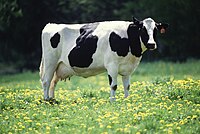
Photo from wikipedia
Abstract This study investigated the effect of milk allowance on the suitability of behavioural and physiological responses, individually and in combination, as early disease indicators. A total of 120 heifer… Click to show full abstract
Abstract This study investigated the effect of milk allowance on the suitability of behavioural and physiological responses, individually and in combination, as early disease indicators. A total of 120 heifer calves were assigned into a 5 L/d or 10 L/d milk allowance treatment group. Daily health checks were conducted to determine when calves presented clinical signs of neonatal calf diarrhoea (NCD). Automated calf feeders recorded milk feeding behaviour, and infrared cameras automatically recorded eye and cheek temperatures. Accelerometers recorded lying behaviour, and water drinking behaviour was recorded using an automated water system and video observations. Respiration rate was recorded once per day by counting flank movements. Calves were used as their own controls, with data analysed relative to the day of clinical identification (d 0). Based on changes which occurred over the 6 days prior to clinical signs of disease (across d -6 to 0), typically, feeding behaviours only changed significantly for calves on the 10 L/d milk allowance with an increase in total (P
Journal Title: Applied Animal Behaviour Science
Year Published: 2020
Link to full text (if available)
Share on Social Media: Sign Up to like & get
recommendations!